Related Research Articles
The diplomatic history of the United States oscillated among three positions: isolation from diplomatic entanglements of other nations ; alliances with European and other military partners; and unilateralism, or operating on its own sovereign policy decisions. The US always was large in terms of area, but its population was small, only 4 million in 1790. Population growth was rapid, reaching 7.2 million in 1810, 32 million in 1860, 76 million in 1900, 132 million in 1940, and 316 million in 2013. Economic growth in terms of overall GDP was even faster. However, the nation's military strength was quite limited in peacetime before 1940.
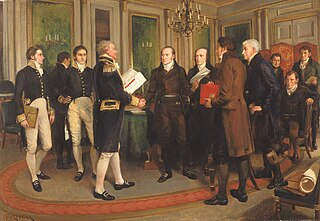
The Treaty of Ghent was the peace treaty that ended the War of 1812 between the United States and the United Kingdom. It took effect in February 1815. Both sides signed it on December 24, 1814, in the city of Ghent, United Netherlands. The treaty restored relations between the two parties to status quo ante bellum by restoring the pre-war borders of June 1812. Both sides were eager to end the war. It ended when the treaty arrived in Washington and was immediately ratified unanimously by the United States Senate and exchanged with British officials the next day.
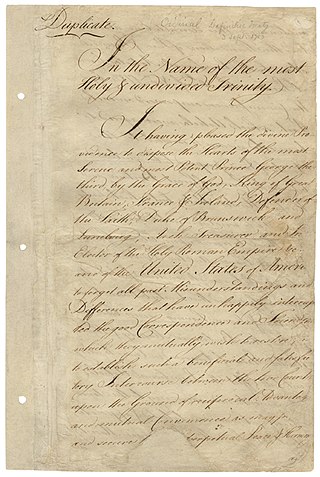
The Treaty of Paris, signed in Paris by representatives of King George III of Great Britain and representatives of the United States on September 3, 1783, officially ended the American Revolutionary War and recognized the Thirteen Colonies, which had been part of colonial British America, as independent, sovereign states.
The Treaty of Berlin was a treaty signed on 24 April 1926 under which Germany and the Soviet Union pledged neutrality in the event of an attack on the other by a third party for five years. The treaty reaffirmed the German-Soviet Treaty of Rapallo (1922).

The First Barbary War (1801–1805), also known as the Tripolitan War and the Barbary Coast War, was a conflict during the Barbary Wars, in which the United States and Sweden fought against Tripolitania. Tripolitania had declared war against Sweden and the United States over disputes regarding tributary payments made by both states in exchange for a cessation of Tripolitatian commerce raiding at sea. United States President Thomas Jefferson refused to pay this tribute. Sweden had been at war with the Tripolitans since 1800. The First Barbary War was the first major American war fought outside the New World, and in the Arab world.

The Barbary Wars were a series of two wars fought by the United States, Sweden, and the Kingdom of Sicily against the Barbary states and Morocco of North Africa in the early 19th century. Sweden had been at war with the Tripolitans since 1800 and was joined by the newly independent US. The First Barbary War extended from 10 May 1801 to 10 June 1805, with the Second Barbary War lasting only three days, ending on 19 June 1815. The Barbary Wars were the first major American war fought entirely outside the New World, and in the Arab World.

The Second Barbary War (1815) or the U.S.–Algerian War was fought between the United States and the North African Barbary Coast states of Tripoli, Tunis, and Algiers. The war ended when the United States Senate ratified Commodore Stephen Decatur's Algerian treaty on 5 December 1815. However, Dey Omar Agha of Algeria repudiated the US treaty, refused to accept the terms of peace that had been ratified by the Congress of Vienna, and threatened the lives of all Christian inhabitants of Algiers. William Shaler was the US commissioner in Algiers who had negotiated alongside Decatur, but he fled aboard British vessels during the 1816 bombardment of Algiers. He negotiated a new treaty in 1816 which was not ratified by the Senate until 11 February 1822, because of an oversight.
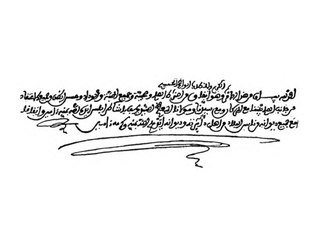
The Treaty of Tripoli was signed in 1796. It was the first treaty between the United States and Tripoli to secure commercial shipping rights and protect American ships in the Mediterranean Sea from local Barbary pirates.

The Barbary pirates, Barbary corsairs, or Ottoman corsairs were mainly Muslim pirates and privateers who operated from the Barbary states. This area was known in Europe as the Barbary Coast, in reference to the Berbers. Slaves in Barbary could be of many ethnicities, and of many different religions, such as Christian, Jewish, or Muslim. Their predation extended throughout the Mediterranean, south along West Africa's Atlantic seaboard and into the North Atlantic as far north as Iceland, but they primarily operated in the western Mediterranean. In addition to seizing merchant ships, they engaged in razzias, raids on European coastal towns and villages, mainly in Italy, France, Spain, and Portugal, but also in the British Isles, the Netherlands, and Iceland.
The Barbary Treaties refer to several treaties between the United States of America and the semi-autonomous North African city-states of Algiers, Tunis, and Tripoli, under the rule of the Ottoman Empire, known collectively as the Barbary States.
The Treaty with Tunis was signed on August 28, 1797, between the United States of America and the Barbary State of Tunis. As the treaty provided in Article One:
The International law bearing on issues of Arab–Israeli conflict, which became a major arena of regional and international tension since the birth of Israel in 1948, resulting in several disputes between a number of Arab countries and Israel.
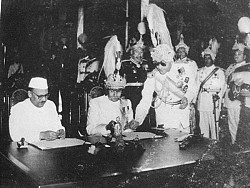
The 1950 India-Nepal Treaty of Peace and Friendship is a bilateral treaty signed by the Kingdom of Nepal and the Republic of India to establish a close strategic relationship between the two South Asian neighbours. The treaty was signed at Kathmandu on 31 July 1950 by the last Rana Prime Minister of Nepal Mohan Shumsher Jang Bahadur Rana and Indian ambassador to Nepal, Chadreshwar Narayan Singh and came into force the same day as per Article 9 of the Treaty. Rana rule in Nepal ended just 3 months after the treaty was signed. The treaty allows free movement of people and goods between the two nations and a close relationship and collaboration on matters of defence and foreign policy.

The Treaty of Amity and Commerce established formal diplomatic and commercial relations between the United States and France during the American Revolutionary War. It was signed on February 6, 1778 in Paris, together with its sister agreement, the Treaty of Alliance, and a separate, secret clause allowing Spain and other European nations to join the alliance. These were the first treaties negotiated by the fledgling United States, and the resulting alliance proved pivotal to American victory in the war; the agreements are sometimes collectively known as the Franco-American Alliance or the Treaties of Alliance.

The Treaty of Fontainebleau was an agreement concluded in Fontainebleau, France, on 11 April 1814 between Napoleon and representatives of Austria, Russia and Prussia. The treaty was signed in Paris on 11 April by the plenipotentiaries of both sides and ratified by Napoleon on 13 April. With this treaty, the allies ended Napoleon's rule as emperor of the French and sent him into exile on Elba.

In July 2001, President Abdelaziz Bouteflika became the first Algerian President to visit the White House since 1985. This visit, followed by a second meeting in November 2001, and President Bouteflika's participation at the June 2004 G8 Sea Island Summit, is indicative of the growing relationship between the United States and Algeria. Since the September 11 attacks in the United States, contacts in key areas of mutual concern, including law enforcement and counter-terrorism cooperation, have intensified. Algeria publicly condemned the terrorist attacks on the United States and has been strongly supportive of the Global War on Terrorism. The United States and Algeria consult closely on key international and regional issues. The pace and scope of senior-level visits has accelerated.
The Treaty of Amity and Commerce Between the United States and Sweden, officially A treaty of Amity and Commerce concluded between His Majesty the King of Sweden and the United States of North America, was a treaty signed on April 3, 1783 in Paris, France between the United States and the Kingdom of Sweden. The treaty officially established commercial relations between these two nations and was signed during the American Revolutionary War.
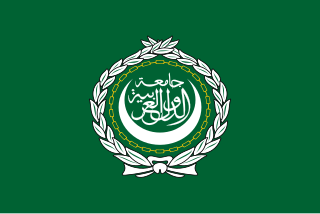
Arab–American relations comprise a rich and nuanced narrative shaped by centuries of interaction, diplomacy, and exchange between the United States and the Arab world. Rooted in historical trade routes and cultural connections dating back to antiquity, the modern iteration of these relations has been profoundly influenced by geopolitical dynamics, economic interests, and cultural exchanges. The United States' engagement with the Arab world gained significant momentum in the aftermath of World War II, as American interests in the region expanded alongside the emergence of Arab nationalism and the pursuit of self-determination. Throughout the Cold War era, the United States navigated intricate alliances and rivalries within the Arab world, often driven by strategic considerations, such as access to oil resources and containment of Soviet influence.
The 1805 Treaty of Tripoli was signed on June 4, 1805, ending the First Barbary War. It was negotiated by Tobias Lear, an ardent Jeffersonian republican, and took effect April 12, 1806 with the signature of President Thomas Jefferson.

A Treaty of Peace and Friendship was signed between the United States and the Regency of Algiers on 5 September 1795.